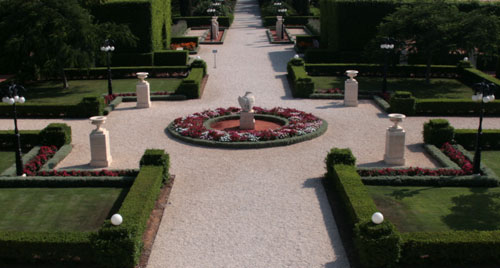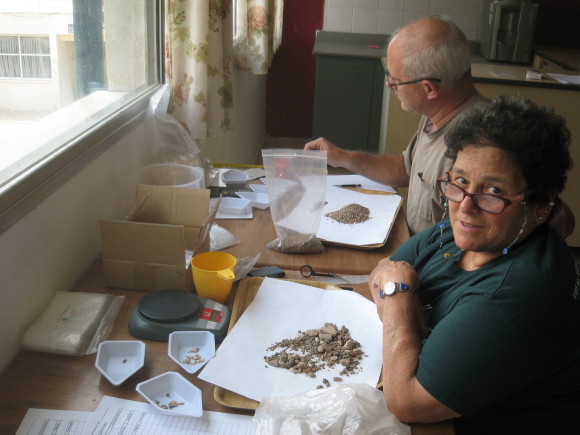Sitting in the lobby of the Renaissance Hotel in Tel Aviv (on points) and watching all the American tourists, it strikes me that they are probably looking at me as well, because I’ve been here for more than two hours already and will probably sit here for another three before I head to the airport. Flights to the U.S. typically leave at 11:00 p.m. or midnight and I had to check out at noon. But the reality is, I’m not wearing plaid or Bermuda shorts or a fanny pack logoed Hard Rock Café. I look like a local in a skirt and blouse and so I look out of place. Continue reading Season’s End
Tag Archives: Tel Akko
The Party’s Over
Today, students and staff placed 2,500 sandbags around the excavations at Tel Akko to protect them over the winter. All the pottery is washed, although not all is catalogued and recorded. The field season for Total Archaeology @ Tel Akko is over. Well, at least in the field. Some staff will remain next week to finish up paperwork and a few more the following week in Haifa to tie up loose ends and complete some of the computer work.
I did not have to place sandbags today, which is a good thing as it is hot and very dirty work. Instead, I was editing some student blog posts and creating a video of some of the students. While all admit that sometimes this is really hard work, most of them loved it, even if they wouldn’t do it again.
Archaeology at the Tel
Trips to museums, shrines and Neandertal caves notwithstanding, what we are doing as part of Total Archaeology at Tel Akko, a joint project of Penn State and the University of Haifa, is archaeology plain and not so simple. We dig, screen dirt, record locations, analyze whatever we find and try to piece together what the site looked like during the Persian, Hellenistic, Phonecian or Canaanite times. We find artifacts that might tell us what people then were doing, where they did it and how. And perhaps someday we will be able to understand it all. For now, a simple glimpse of life at Tel Akko.
Parallel Universes
Last weekend we had a trip to a series of varied, but interesting, locations. I found myself unable to walk the distances necessary at some of the sites, but that did not mean my trip was any less enjoyable.
 First stop was right here in Akko, at the Bahá’í Shrine. If anyone is at all familiar with Bahá’í locations, it is probably with the shrine in Haifa dedicated to the Báb, founder of the Bábí faith and forerunner of the Bahá’í faith. The Bahá’í faith, begun by the Bahá’u’lláh, a follower of the Báb, in Persia during the 1800s, is a world religion based on universal acceptance of all religions as valid and a belief that all religions believe in the same divinity. Bahá’u’lláh, unlike the Báb who was executed in Persia, was simply exiled to the Ottoman Empire. He settled in Akko, which was part of the Ottoman Empire at the time. He was also arrested and imprisoned for more than 15 years in the Akko prison and spent the rest of his life under house arrest here, all because he proposed a new religion. So Akko is the holiest place in the world for a member of the Bahá’í faith and there are many Bahá’í followers in Akko. Continue reading Parallel Universes
First stop was right here in Akko, at the Bahá’í Shrine. If anyone is at all familiar with Bahá’í locations, it is probably with the shrine in Haifa dedicated to the Báb, founder of the Bábí faith and forerunner of the Bahá’í faith. The Bahá’í faith, begun by the Bahá’u’lláh, a follower of the Báb, in Persia during the 1800s, is a world religion based on universal acceptance of all religions as valid and a belief that all religions believe in the same divinity. Bahá’u’lláh, unlike the Báb who was executed in Persia, was simply exiled to the Ottoman Empire. He settled in Akko, which was part of the Ottoman Empire at the time. He was also arrested and imprisoned for more than 15 years in the Akko prison and spent the rest of his life under house arrest here, all because he proposed a new religion. So Akko is the holiest place in the world for a member of the Bahá’í faith and there are many Bahá’í followers in Akko. Continue reading Parallel Universes
Origin (and Demise) of an Idea
For a few days now I’ve been helping with some archaeobotany. Anyone who knows me knows I don’t really like biology, being more of a physical sciences kind of gal, but, this is interesting. We take soil samples that are “floated” to find any seeds, and other organic remains. In the process, there is a portion of the sample that falls to the bottom of the tank of water, the heavy fraction. I’ve been sorting through the heavy fractions. We find shells, pieces of pottery, bronze, lead and bones. On some of the samples, when we run a magnet over them we get pieces of slag, the remains of iron ore processing, and hammer scales, the remains of iron tool making. These are tiny blobs of iron that are forced off when the hot metal is struck. The samples are sort of a grab bag of the areas we are working as part of Total Archaeology at Tel Akko, a joint project of Penn State and Haifa University.

